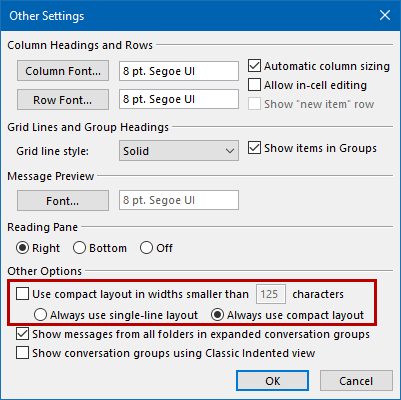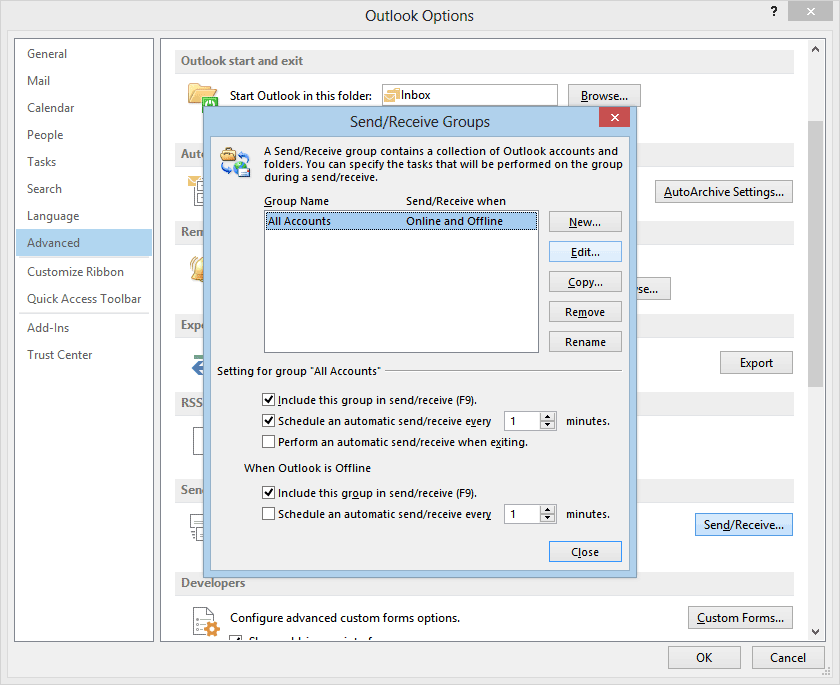- As I said I already have all the GP's that you said (for the most part you put 2003 settings and some changed in 2013). The issue isn't getting outlook into Headers only mode I am already doing that it is once in that mode it will first only download the headers but as you click though your inbox it actually downloads the full item and I was just looking for a setting to stop that from.
- Outlook 2016 won't download messages. I can 'Download Headers' and get the headers for all messages, then 'Mark to Download', and then 'Process Marked Headers' and it will download the marked messages. But 'Send/Receive All Folders' only sends messages in Outbox. 'Mail' app works fine but Outlook 2016 just started this problem after latest reboot.
Note: for slower connections like cellular hot spots, you might want to consider to check the Download message headers only box. Close the Accounts dialog. You are all set 🙂; Manually update Outlook web app. A couple of readers asked whether there is a possibility to trigger an auto update of the Outlook.com web client inbox.

This tutorial contains step-by-step instructions on how you can view the email message source, (aka 'Message Headers' or 'Full Headers' or 'Mail Headers or 'Internet headers'), on the following email clients/programs: Outlook, Thunderbird, Gmail, Outlook for Web, & Yahoo.
The message source of an email message contains detailed information about the message such as which servers the message went through until it reaches you, or the sender's email client-program.
Message source information is commonly used to find out why an email was not delivered to recipients. For example, if one of your emails is not delivered, you will receive a notice on why your message was not delivered, from the 'Mail Delivery Subsystem' or 'Mailer-Daemon', with a subject 'Mail delivery failed: returning message to sender'. At such case, you can use the message source detailed report, to find out which server failed to deliver the message.
e.g. The Message Source of a 'Mail Delivery Failed' report, typically contains the following information:
1. The IP Address of the server that bounces the message and the date – time the message was returned (bounced) back to you.
e.g 'Received: by 10.31.210.195 with SMTP id j186csp81133vkg; Wed, 28 Oct 2015'
2. The mail server name (MAILER DAEMON) that bounced the message:
e.g. 'From: Mail Delivery Subsystem <mailer-daemon@googlemail.com>
To: <YourEmailAddress>'.
3. The reason why the message has returned to you (bounced).
Example No1: 'A message that you sent could not be delivered to one or more of its
recipients. This is a permanent error. The following address(es) failed: user@example.com'
Example No2: 'Technical details of permanent failure:=20
Google tried to deliver your message, but it was rejected by the server for=
the recipient domain example.com by mail.example.com. [<Mail Server IP Address>].
The error that the other server returned was: 550 Administrative prohibition'
4. The last section contains the original message that was bounced.
How to View Message Source (Message Headers) in Email Messages.
* Note:Keep in mind that if you use a local email client program such as Outlook, Thunderbird, etc., you can view the full message source only if you use a POP account. IMAP accounts don't support the view of the full message source but only the 'basic' Internet Headers.
How to view Message Source in Outlook 2016, 2019.
1. Open the message that you want to view its message source.
2. From the File menu choose Properties.
3. You'll find the message source at Internet Headers section.
TIP: If you want to view the message header without opening the email message:
1. Open Outlook and go to File -> Options -> Customize Ribbon.
2. Set the 'Choose commands from' to Commands Not in the Ribbon
3. Click New Group and then click Rename.
4. Name the New Group as Message Source.
5. Select Message Options from the commands list, click Add and then OK.
6. From now on, select the email message and click the Message Source on the ribbon, to view its source.
How to view Message Headers in Outlook 2010 or Outlook 2013:
1. Open the message your want to view its message source.
2. Next to Move item in the ribbon, click Actions -> Other Actions -> View Source, or click the File menu, select Properties and see the Internet Headers section.
How to view Internet Headers in Outlook 2007 & Outlook 2003:
1. Open the message in Microsoft Outlook.
2. On the ribbon click the small icon next to Options.
3. View the Internet Headers section.
How to view Message Headers in Thunderbird.
1. Select the message you'd like to view its source.
2. From the main menu select View > Message Source.
How to view email headers in GMAIL.
1. Open the message you'd like to view.
2. Click the down arrow next to Reply , at the top of the message pane.
3. Select Show Original.
How to view Message Source in OUTLOOK for WEB.

To view the full message headers in Outlook.com, right-click the message you'd like to view its source and select View Message Source.
How to view Message Source in YAHOO MAIL
1. Select the message you'd like to view its source.
2. Click Actions dropdown menu and select View Full Header.
That's it! Let me know if this guide has helped you by leaving your comment about your experience. Please like and share this guide to help others.
We're hiring
We're looking for part-time or full-time technical writers to join our team! It's about a remote position that qualified tech writers from anywhere in the world can apply. Click here for more details.
Full household PC Protection - Protect up to 3 PCs with NEW Malwarebytes Anti-Malware Premium!
If you are having problems with your email, one common diagnostic aid is a complete list of the message's headers. Headers show the path a message took to get from the sender to the recipient. The IT Service Desk or other technical support may ask you to provide a message's headers.
- Right-click (or ctrl-click) the message in your Inbox or other folder (do not open the message).
- From the menu that appears, select View Source.
Headers Only In Outlook 2016 Pdf

Your text editor (typically an application called TextEdit) will open, displaying all the headers for the message, followed by the message body.
If you need to copy the headers (to paste somewhere else),
Headers Only In Outlook 2016 File
- Drag over the text from the beginning of the text to the beginning of the body of the message.
- Press command-c on your keyboard; this copies the highlighted text to the clipboard.
- Then, with an email message or other document open, press command-v to paste the header text into that document.